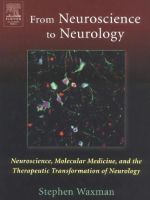
From Neuroscience to Neurology
Автор: Stephen Waxman
Год: 2005
Страницы: 547
Язык: Английский
Издательство: Elsevier Inc
Описание:
When I was a boy about five years old, I asked a grownup "will men ever be able to travel to the moon?" and the answer was "it's impossible."
Less than two decades later, as a medical student working in London, I watched on television as a man walked on the moon. The "impossible" had become possible.
This book focuses on the remarkable transformation that has occurred within neurology, a transformation from the "impossible" to the possible.
Twenty-five years ago computed tomography had just become available and was rapidly evolving, but magnetic resonance imaging was not yet feasible in the clinical realm. Medical students at some institutions were taught to try not to make the diagnosis of multiple sclerosis early in its course, since there was little that could be done. Some senior neurologists—good clinicians—made the diagnosis of MS and then walked away from the bed¬side, since there was little to offer in the way of effective therapy. Peripheral neuropathies were regarded as unbeatable. Strokes were treated with bed rest, and not much else.
Содержание(просмотреть)
Preface. vii
Contributors. ix
I. Clinical Rewards From Neuroscience, Molecular Medicine, and Translational Research
Seeing the Brain So We Can Save It: The Evolution of Magnetic Resonance Imaging as a Clinical Tool. 3
Advances in the Acute Treatment and Secondary Prevention of Stroke. 21
Preserving Function in Acute Nervous System Injury. 35
Slowing the Progression of Multiple Sclerosis. 61
The Emergence of Neurosurgical Approaches to the Treatment of Epilepsy. 81
6. The Neurobiology of Migraine and Transformation of Headache Therapy. 107
Botulinum Toxins: Transformation of a Toxin into a Treatment. 125
Prospects for Slowing the Progression of Parkinson's Disease. 141
Current Neurosurgical Treatments for Parkinson's Disease: Where Did They Come From? 159
Treatable Peripheral Neuropathies: Plasma Exchange, Intravenous Immunoglobulin, and Other Emerging Therapies. 175
Molecular Pharmacology and the Treatment of Tourette's Syndrome and Attention Deficit-Hyperactivity Disorder. 183
Neuroscience, Molecular Medicine, and New Approaches to the Treatment of Depression and Anxiety. 193
II. Moving Toward The Clinic: Evolving Themes and Technologies
Genomics Proteomics, and Neurology. 217
Neuroprotection: Where Are We Going? 237
Prospects for Gene Therapy for Central Nervous System Disease. 267
Therapeutics Development for Hereditary Neurological Diseases. 285
Inherited Channelopathies of the CNS: Lessons for Clinical Neurology. 293
Inherited Channelopathies of Muscle: Implications for Therapy. 303
Transcriptional Channelopathies of the Nervous System: New Targets for Molecular Medicine. 319
New Molecular Targets for the Treatment of Neuropathic Pain. 339
Therapeutic Transfer and Regeneration of Neural Progenitors or Neurons in Gray Matter of the Adult Brain. 357
Cellular Plasticity of the Adult Human Brain. 375
Harnessing Endogenous Stem Cells for Central Nervous System Repair. 387
Neuropathies—Translating Causes into Treatments. 405
Therapeutic Potential of Neurotrophic Factors. 419
Promoting the Regeneration of Axons within the Central Nervous System. 443
Alzheimer's Disease: Clinical Features, Neuropathological and Biochemical Abnormalities, Genetics, Models, and Experimental Therapeutics. 445
Behavioral Intervention and Recovery from CNS Damage. 459
What Functional Brain Imaging Will Mean for Neurology. 471
Index. 493

